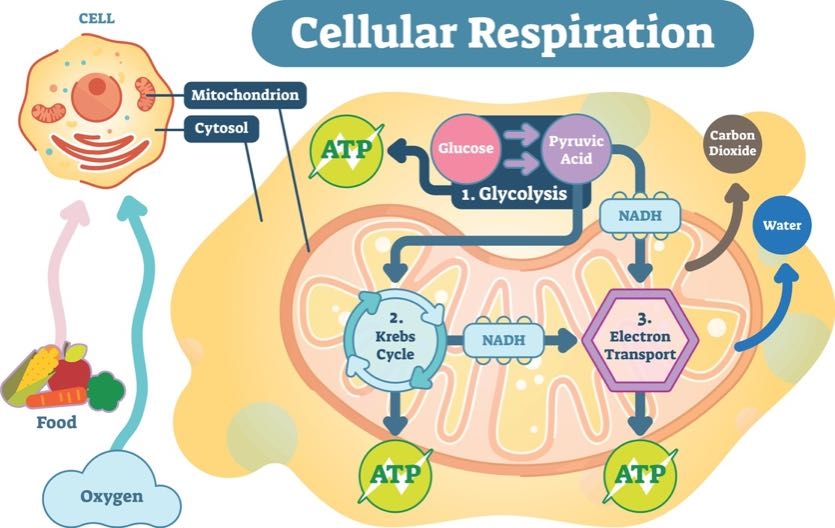Describe Cellular Activities That Use the Energy Released by Atp.
What molecule is made to create when a phosphate groups is released from ATP. The bond between the second phosphate and last phosphate groups yields the most energy about seven kilocalories per mole.

Understanding Atp 10 Cellular Energy Questions Answered Ask The Scientists
Then when the phosphate bond is broken and the energy released the cell can use the energy for activities such as making a protein or transporting mol- ecules through the plasma membrane.

. Cellular respiration Energy from nutrients is converted into ATP. Triphosphate ATP Where do macromolecules store energy until ATP transferred to ATP. They regenerate it from ADP as they need it using energy stored in food.
Think of ATP as a common currency for the cells in your body. ATP is the most abundant energy-carrying molecule in your body. These include intracellular signaling DNA and RNA synthesis Purinergic signaling synaptic signaling active transport and muscle contraction.
Which arrow in Model 3 represents phosphorylation A or B. Cells contain only a small amount of ATP at any one time. G3P is oxidized and phosphorylated forming NADH and BPG 4.
Energy provided by ATP is used in active transport to contract muscles to make proteins and in many other ways. Cells release energy from ATP molecules by subtracting a phosphate group. Hydrolysis Breaking a bond in a molecule and splitting it into smaller molecules through a reaction with water.
1- Select the statements that describe the energy cells use to drive cell processes. The energy of the ATP molecule lies in the bonds between the phosphate groups or pyrophosphate bonds states Dr. ATP consists of adrenine a 5-carbon sugar called ribose and three phosphate groups.
Other functions of ATP include supplying the energy required for the muscle contraction circulation of blood locomotion and various body movements. Signal transduction The transmission of signals from a cells outside to its inside. A 6-carbon sugar is split to yield 2 molecules of G3P 3.
D- Plants use the energy in sunlight to power cell processes when ATP is not. ATP adenosine triphosphate is the energy-carrying molecule used in cells because it can release energy very quickly. This process is called cellular respiration.
C- ATP and carbohydrates are reservoirs of chemical energy. Simply by breaking the chemical bond between the 2nd and 3rd phosphates energy is released ATP has enough energy to power a variety of cellular activities including active transport across cell membranes protein synthesis and muscle contraction what is the ultimate source of energy for plants. Photosynthesis is a process that.
B- The energy stored in chemical bonds is a form of potential energy. This cellular process is similar to the way energy in batteries is used by a radio. This breakdown of ATP to release the stored energy within its high energy phosphate bonds is called ATP.
It is the basic energy source of all cells. How is the energy that is stored in ATP released. Phosphates are transferred from BPG to ATP and pyruvate are produces during glycolysis ATP is formed via substrate-level phosphorylation.
During any cellular activity the energy is supplied by the breakdown of a phosphate bond releasing the stored energy. What is the role of ATP in cellular activities. Describe one cellular activity that uses the energy released by ATP.
A principal chemical compound that cells use to store and release energy. Explain why this process is called phosphorylation b. The energy released by hydrolysis breakdown of ATP is used to power many energy-requiring cellular reactions.
Examples of cellular activities that require energy. Living things use chemical fuels as well one of the principal chemical compounds that cells useto store and release energy is adenosine triphosphate ATP. Cell division synthesis of proteins from amino acids active transport muscle cell contraction in animal bodies transmission of nerve impulses.
A- ATP is a form of long-term energy storage in plants. Describe one cellular activity that uses the energy released by ATP. Mike Farabee of Estrella Mountain Community College.
Energy is released from ATP when the. Describe photosynthesis in one sentence. Use a complete sentence to describe at least two other examples of when a cell may need to use ATP as a source of energy.
It can be thought of as the main energy currency of cells much as money is the main economic currency of human societies. Adenosine triphosphate or ATP is a small relatively simple molecule. These topics are not an exhaustive list but include some of the vital roles ATP performs.
Glucose is converted to a 6-carbon diphosphate sugar requiring 2 ATP molecules 2. The reaction to convert ADP back to ATP is called phosphorylation. The food you eat is digested into small subunits of macronutrients.
Variety - including active. Kinase An enzyme that transfers a phosphate group from ATP to another molecule. 5 kjmol of energy and producing ADP adenosine diphosphate and an inorganic phosphate.
This approximately releases 30. The ATP is used for various cellular functions including transportation of different molecules across cell membranes. It harnesses the chemical energy found in food molecules and then releases it to fuel the work in the cell.
What is the molecule that carries chemical energy for your cell use. ATP hydrolysis provides the energy needed for many essential processes in organisms and cells.

Cellular Respiration Is The Process In Which The Solar Energy Stored In Organic Molecules Cellular Respiration Photosynthesis And Cellular Respiration Cellular

Atp Diagrams Study Guide Print And Digital Biology Classroom Chemical Energy Biology Resources

Cellular Respiration Is The Process Where The Solar Energy Stored In Organic Molecules Like Glucose Is Re Cellular Respiration Biology Activity Science Biology

No comments for "Describe Cellular Activities That Use the Energy Released by Atp."
Post a Comment